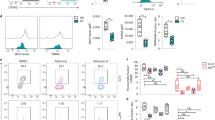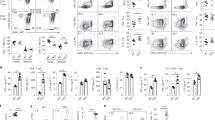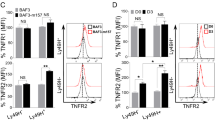Abstract
Interleukin 15 (IL-15) controls both the homeostasis and the peripheral activation of natural killer (NK) cells. The molecular basis for this duality of action remains unknown. Here we found that the metabolic checkpoint kinase mTOR was activated and boosted bioenergetic metabolism after exposure of NK cells to high concentrations of IL-15, whereas low doses of IL-15 triggered only phosphorylation of the transcription factor STAT5. mTOR stimulated the growth and nutrient uptake of NK cells and positively fed back on the receptor for IL-15. This process was essential for sustaining NK cell proliferation during development and the acquisition of cytolytic potential during inflammation or viral infection. The mTORC1 inhibitor rapamycin inhibited NK cell cytotoxicity both in mice and humans; this probably contributes to the immunosuppressive activity of this drug in different clinical settings.
This is a preview of subscription content, access via your institution
Access options
Subscribe to this journal
Receive 12 print issues and online access
$209.00 per year
only $17.42 per issue
Buy this article
- Purchase on Springer Link
- Instant access to full article PDF
Prices may be subject to local taxes which are calculated during checkout







Similar content being viewed by others
References
Vivier, E., Tomasello, E., Baratin, M., Walzer, T. & Ugolini, S. Functions of natural killer cells. Nat. Immunol. 9, 503–510 (2008).
Spits, H. et al. Innate lymphoid cells–a proposal for uniform nomenclature. Nat. Rev. Immunol. 13, 145–149 (2013).
Walzer, T. et al. Natural killer cell trafficking in vivo requires a dedicated sphingosine 1-phosphate receptor. Nat. Immunol. 8, 1337–1344 (2007).
Luci, C. et al. Influence of the transcription factor RORγt on the development of NKp46+ cell populations in gut and skin. Nat. Immunol. 10, 75–82 (2009).
Sanos, S.L. et al. RORγt and commensal microflora are required for the differentiation of mucosal interleukin 22–producing NKp46+ cells. Nat. Immunol. 10, 83–91 (2009).
Satoh-Takayama, N. et al. Microbial flora drives interleukin 22 production in intestinal NKp46+ cells that provide innate mucosal immune defense. Immunity 29, 958–970 (2008).
Chiossone, L. et al. Maturation of mouse NK cells is a 4-stage developmental program. Blood 113, 5488–5496 (2009).
Hayakawa, Y. & Smyth, M.J. CD27 dissects mature NK cells into two subsets with distinct responsiveness and migratory capacity. J. Immunol. 176, 1517–1524 (2006).
Cooper, M.A. In vivo evidence for a dependence on interleukin 15 for survival of natural killer cells. Blood 100, 3633–3638 (2002).
Kennedy, M.K. et al. Reversible defects in natural killer and memory CD8 T cell lineages in interleukin 15-deficient mice. J. Exp. Med. 191, 771–780 (2000).
Lodolce, J.P. et al. IL-15 receptor maintains lymphoid homeostasis by supporting lymphocyte homing and proliferation. Immunity 9, 669–676 (1998).
Vosshenrich, C.A.J. et al. Roles for common cytokine receptor γ-chain-dependent cytokines in the generation, differentiation, and maturation of NK cell precursors and peripheral NK cells in vivo. J. Immunol. 174, 1213–1221 (2005).
Mortier, E. et al. Macrophage- and dendritic-cell-derived interleukin-15 receptor α supports homeostasis of distinct CD8+ T cell subsets. Immunity 31, 811–822 (2009).
Lee, G.A. et al. Different NK cell developmental events require different levels of IL-15 trans-presentation. J. Immunol. 187, 1212–1221 (2011).
Orr, S.J., Quigley, L. & Mcvicar, D.W. In vivo expression of signaling proteins in reconstituted NK cells. J. Immunol. Meth. 340, 158–163 (2009).
Orr, S.J. et al. Implications for gene therapy-limiting expression of IL-2R c delineate differences in signaling thresholds required for lymphocyte development and maintenance. J. Immunol. 185, 1393–1403 (2010).
Eckelhart, E. et al. A novel Ncr1-Cre mouse reveals the essential role of STAT5 for NK-cell survival and development. Blood 117, 1565–1573 (2011).
Pearce, E.L. & Pearce, E.J. Metabolic pathways in immune cell activation and quiescence. Immunity 38, 633–643 (2013).
Chang, C.-H. et al. Posttranscriptional control of T cell effector function by aerobic glycolysis. Cell 153, 1239–1251 (2013).
Sinclair, L.V. et al. Phosphatidylinositol-3-OH kinase and nutrient-sensing mTOR pathways control T lymphocyte trafficking. Nat. Immunol. 9, 513–521 (2008).
Laplante, M. & Sabatini, D.M. mTOR signaling in growth control and disease. Cell 149, 274–293 (2012).
Magnuson, B., Ekim, B. & Fingar, D.C. Regulation and function of ribosomal protein S6 kinase (S6K) within mTOR signalling networks. Biochem. J. 441, 1–21 (2011).
Wang, R. & Green, D.R. Metabolic checkpoints in activated T cells. Nat. Immunol. 13, 907–915 (2012).
Baranek, T. et al. Differential responses of immune cells to type I interferon contribute to host resistance to viral infection. Cell Host Microbe 12, 571–584 (2012).
Fehniger, T.A. et al. Acquisition of murine NK cell cytotoxicity requires the translation of a pre-existing pool of granzyme B and perforin mRNAs. Immunity 26, 798–811 (2007).
Risson, V. et al. Muscle inactivation of mTOR causes metabolic and dystrophin defects leading to severe myopathy. J. Cell Biol. 187, 859–874 (2009).
Narni-Mancinelli, E. et al. Fate mapping analysis of lymphoid cells expressing the NKp46 cell surface receptor. Proc. Natl. Acad. Sci. USA 108, 18324–18329 (2011).
Gordon, S.M. et al. The transcription factors T-bet and Eomes control key checkpoints of natural killer cell maturation. Immunity 36, 55–67 (2012).
Kim, S. et al. In vivo developmental stages in murine natural killer cell maturation. Nat. Immunol. 3, 523–528 (2002).
Nguyen, K.B. et al. Coordinated and distinct roles for IFN-αβ, IL-12, and IL-15 regulation of NK cell responses to viral infection. J. Immunol. 169, 4279–4287 (2002).
Dokun, A.O. et al. Specific and nonspecific NK cell activation during virus infection. Nat. Immunol. 2, 951–956 (2001).
Sun, J.C., Ma, A. & Lanier, L.L. Cutting Edge: IL-15-independent NK cell response to mouse cytomegalovirus infection. J. Immunol. 183, 2911–2914 (2009).
Johnson, S.C., Rabinovitch, P.S. & Kaeberlein, M. mTOR is a key modulator of ageing and age-related disease. Nature 493, 338–345 (2013).
Feldman, M.E. et al. Active-site inhibitors of mTOR target rapamycin-resistant outputs of mTORC1 and mTORC2. PLoS Biol. 7, e38 (2009).
García-Martínez, J.M. et al. Ku-0063794 is a specific inhibitor of the mammalian target of rapamycin (mTOR). Biochem. J. 421, 29–42 (2009).
Delgoffe, G.M. et al. The mTOR kinase differentially regulates effector and regulatory T cell lineage commitment. Immunity 30, 832–844 (2009).
Frauwirth, K.A. et al. The CD28 signaling pathway regulates glucose metabolism. Immunity 16, 769–777 (2002).
Lee, K. et al. Mammalian target of rapamycin protein complex 2 regulates differentiation of Th1 and Th2 cell subsets via distinct signaling pathways. Immunity 32, 743–753 (2010).
Watzl, C. & Long, E.O. in Current Protocols in Immunology (ed. Coligan, J.E.) Ch. 11, Unit 11.9B (Wiley, 2010).
Salmond, R.J., Emery, J., Okkenhaug, K. & Zamoyska, R. MAPK, Phosphatidylinositol 3-kinase, and mammalian target of rapamycin pathways converge at the level of ribosomal protein S6 phosphorylation to control metabolic signaling in CD8 T cells. J. Immunol. 183, 7388–7397 (2009).
Frias, M.A. et al. mSin1 is necessary for Akt/PKB phosphorylation, and its isoforms define three distinct mTORC2s. Curr. Biol. 16, 1865–1870 (2006).
Finlay, D.K. et al. PDK1 regulation of mTOR and hypoxia-inducible factor 1 integrate metabolism and migration of CD8+ T cells. J. Exp. Med. 209, 2441–2453 (2012).
Tassi, I. et al. p110gamma and p110δ phosphoinositide 3-kinase signaling pathways synergize to control development and functions of murine NK cells. Immunity 27, 214–227 (2007).
Guo, H., Samarakoon, A., Vanhaesebroeck, B. & Malarkannan, S. The p110 of PI3K plays a critical role in NK cell terminal maturation and cytokine/chemokine generation. J. Exp. Med. 205, 2419–2435 (2008).
Kim, N. et al. The p110δ catalytic isoform of PI3K is a key player in NK-cell development and cytokine secretion. Blood 110, 3202–3208 (2007).
Hand, T.W. et al. Differential effects of STAT5 and PI3K/AKT signaling on effector and memory CD8 T-cell survival. Proc. Natl. Acad. Sci. USA 107, 16601–16606 (2010).
Clinthorne, J.F., Beli, E., Duriancik, D.M. & Gardner, E.M. NK cell maturation and function in C57BL/6 mice are altered by caloric restriction. J. Immunol. 190, 712–722 (2013).
Thoreen, C.C. et al. A unifying model for mTORC1-mediated regulation of mRNA translation. Nature 485, 109–113 (2012).
Jacinto, E. et al. Mammalian TOR complex 2 controls the actin cytoskeleton and is rapamycin insensitive. Nat. Cell Biol. 6, 1122–1128 (2004).
Marçais, A. et al. Regulation of mouse NK cell development and function by cytokines. Front. Immunol. 4, 450 (2013).
Acknowledgements
We thank the Plateau de Biologie Expérimentale de la Souris, and the flow cytometry facility of the SFR Biosciences Gerland and of Institute for Research on Cancer and Aging, Nice (the Cytomed platform funded by the CG06, INSERM and FEDER). Supported by the FINOVI foundation (T.W. laboratory), Agence Nationale de la Recherche (for the T.W. laboratory), the European Research Council (ERC-Stg 281025 for the T.W. laboratory and a THINK Advanced Grant for the E.V. laboratory), Institut National de la Santé et de la Recherche Médicale (T.W. and E.V. laboratories), Centre National de la Recherche Scientifique (T.W. and E.V. laboratories), Université Claude Bernard Lyon1 (T.W. laboratory), Ecole Normale Superieure de Lyon (T.W. laboratory), the “Ligue contre le Cancer” (“équipe labelisée”; E.G. and E.V. laboratories) and Aix-Marseille University to Centre d'Immunologie de Marseille Luminy (E.V. laboratory).
Author information
Authors and Affiliations
Contributions
A.M., J.C.-V., C.V., S.D., S.V., A.F., J.R., K.M. and A.T. did experiments; T.W. designed the study with the help of A.M., J.B., Y.-G.G., E.G. and E.V.; and A.M. and T.W. wrote the manuscript.
Corresponding author
Ethics declarations
Competing interests
The authors declare no competing financial interests.
Integrated supplementary information
Supplementary Figure 1 NK cell metabolism is regulated developmentally and following activation.
(a) Histograms represent FSC and SSC of BM NK (NK1.1+ CD3-CD19-) cell subsets as defined by the expression of CD27 and CD11b, one representative experiment out of 5 is shown. The bar graph shows averaged FSC and SSC MFI of BM and splenic NK cell subsets (n=5 mice in 3 independent experiments). MFI is normalized to the BM CD11blo subset. (b) Splenocytes were cultured in the presence of 100ng/ml IL-15 and analyzed after 24 to 48h. The FSC and SSC of NK cells present in the culture are shown. One representative experiment out of many is shown. (c) The FSC and SSC of NK cells from the spleen of Control or poly(I:C) injected mice are shown. One representative experiment out of many is shown. (d) The FSC and SSC of NK cells from the draining lymph nodes of Control or intranasaly Influenza infected mice at day 3 are shown. One representative experiment out of 3 is shown.
Supplementary Figure 2 mTOR activity decreases as differentiation progresses.
The bar graph shows averaged phosphoproteins MFI of BM and splenic NK cell subsets (n=4 mice in 4 independent experiments). MFI is normalized to the CD11blo subset in the BM.
Supplementary Figure 3 Gating strategies.
(a) Gating strategy employed to analyze BM, Spleen, Liver and Blood NK cells. (b) Gating strategy employed to analyze NK, ILC3 NKR+ and LTi cells in the gut.
Supplementary Figure 4 Characterization of NK-Mtor-/- mice.
(a) Representative histograms show mTOR expression in CD11blo splenic NK cells and in T cells of NK-MtorWT/WT and NK-Mtor-/- mice. Staining obtained using a control isotype is shown. The bar graph shows averaged mTOR MFI among the different NK cell subsets in the BM and Spleen (n=4 mice in 3 independent experiments). Data are normalized to the CD11blo subset of the BM. Doted line represents the limit of detection. (b) The bar graph shows averaged FSC and SSC MFI of CD11blo NK cells from the BM and Spleen of NK-MtorWT/WT and NK-Mtor-/- mice (n=4 mice in 3 independent experiments). (c) Histograms represent phosphorylation levels of different proteins in CD11blo NK cells from the BM of NK-MtorWT/WT and NK-Mtor-/- mice. Staining obtained with an isotype control is shown. The bar graph shows the averaged MFI of different phosphoproteins as indicated (n=4 mice in 4 independent experiments). (d) Representative flow cytometric analysis showing NKp46 and RORγt expression in gut CD45+ CD19- CD3- lymphoid cells from NK-MtorWT/WT and NK-Mtor-/- mice. The bar graphs show percentages of the indicated subsets. Each point represents a single mouse (n=4 mice in 2 independent experiments).
Supplementary Figure 5 mTOR controls NK cell maturation.
(a) The bar graphs show averaged repartition of BM and Spleen NK cells from NK-MtorWT/WT and NK-Mtor-/- mice in each subset as defined by CD27 and CD11b expression (n=4 mice in 3 independent experiments. (b) Histograms show Ly49H expression level of NK cells from NK-MtorWT/WT and NK-Mtor-/- mice in each subset. The bar graphs show averaged percentage of Ly49H expressing cells among BM and Spleen NK cell of the different subsets (n=4 mice in 3 independent experiments). (c) MFI of the indicated marker was measured on CD11b- BM NK cells from NK-MtorWT/WT and NK-Mtor-/- mice. The bar graph shows the average of the ratio of MFIs NK-Mtor-/- over NK-MtorWT/WT NK cells for each marker (n=3 mice in 3 independent experiments). The red line indicates a ratio of 1.
Supplementary Figure 6 mTOR is necessary for NK cell proliferation in the BM and maximal expression of IL-15R.
(a) CD45.1 MtorWT/WT or CD45.2 Mtorlox/lox splenocytes were treated in vitro with TATCre as described in the Methods section and transferred into CD45.1/CD45.2 hosts. 3 days later, the CD45.2 Mtorlox/lox / CD45.1 MtorWT/WT ratio in the spleen was determined. The average of 3 independent experiments is shown (n=6 mice). (b) Flow cytometric analyzes show Ki67 staining of CD11blo subset BM NK cells from NK-MtorWT/WT and NK-Mtor-/- mice. One representative experiment is shown. The bar graph shows average percentages of Ki67 positive cells (n=6 mice in 3 independent experiments). (c) The bar graph shows averaged MFI of CD122, CD132 and pSTAT5 in CD11blo BM NK cells from NK-MtorWT/WT and NK-Mtor-/- mice (n=4 mice in 4 independent experiments). (d) CD122 MFI of TATCre treated NK cells of the indicated genotype was measured 3 days after transfer and is shown (n=5 mice in 3 independent experiments).
Supplementary Figure 7 Defective NK cell activation in the absence of mTOR.
(a-d) NK-MtorWT/WT and NK-Mtor-/- mice were injected or not with poly(I:C) and sacrificed 18h later. Spleens were harvested and cell suspension analyzed by flow cytometry. The CD11blo NK cell subset was gated and the results are presented. (a) Histograms represent phosphorylation levels of different proteins as indicated. One representative experiment is shown (n=4). (b) Histograms represent expression of CD71, CD98 and CD69 or the level of 2-NBDG staining (n=4). The numbers indicate the geometric mean fluorescence intensity. (c) Histograms show intracellular expression of GzmB and GzmA. One representative experiment is shown (n=4). (d) Splenocytes were cultured for 1h on plates coated with the indicated antagonistic antibodies or with the indicated cytokine. Cells were subsequently stained and analyzed by flow cytometry. Flow cytometric analyzes from one representative experiment are shown for the control, NKp46 and IL-12/18 stimulation conditions. The bar graphs show the averaged percentages of CD107a and IFNγ positive cells of 3 experiments. (e) As in Fig. 6e for KLRG1 and intracellular CCL3. To assess degranulation, cells were incubated for 4h in vitro with an anti-CD107a antibody before staining. The proportion of positive NK cells for each of these markers (average +/- SD and individual mouse, statistical comparisons have been made between WT and mTOR deficient NK cells for each time point) is shown (4 independent experiments, n>6).
Supplementary Figure 8 Acute inhibition of mTOR abrogates inflammation-induced priming.
(a) Rapamycin treated or non-treated mice were injected with poly(I:C) and sacrificed 18h later. Splenocytes were analyzed by flow cytometry. The graphs show the averaged MFI for pAkt S473 in gated NK cells. Each dot represents a single mouse, bars indicate average and SD (n=9 mice in 4 independent experiments for poly(I:C) and 18 mice in 4 independent experiments for Rapa+poly(I:C)). The MFI was normalized to control non-poly(I:C) injected mice. (b) The graph shows averaged MFI of CD69 in NK cells from control or poly(I:C) injected animals, treated or not with Rapamycin (n=4 mice in 4 independent experiments). (c) Human PBMCs were cultured for 36h as indicated. Cells were then stained and analyzed by flow cytometry. The bar graphs show the averaged MFI for Perforin1 in gated NK cells (n=9 individual donors in 3 independent experiments).
Supplementary information
Supplementary Text and Figures
Supplementary Figures 1–8 and Tables 1–2 (PDF 3213 kb)
Rights and permissions
About this article
Cite this article
Marçais, A., Cherfils-Vicini, J., Viant, C. et al. The metabolic checkpoint kinase mTOR is essential for IL-15 signaling during the development and activation of NK cells. Nat Immunol 15, 749–757 (2014). https://doi.org/10.1038/ni.2936
Received:
Accepted:
Published:
Issue Date:
DOI: https://doi.org/10.1038/ni.2936
This article is cited by
-
MEF2C regulates NK cell effector functions through control of lipid metabolism
Nature Immunology (2024)
-
CIS deletion by CRISPR/Cas9 enhances human primary natural killer cell functions against allogeneic glioblastoma
Journal of Experimental & Clinical Cancer Research (2023)
-
The TNFα/TNFR2 axis mediates natural killer cell proliferation by promoting aerobic glycolysis
Cellular & Molecular Immunology (2023)
-
SEL1L preserves CD8+ T-cell survival and homeostasis by fine-tuning PERK signaling and the IL-15 receptor-mediated mTORC1 axis
Cellular & Molecular Immunology (2023)
-
STING-induced regulatory B cells compromise NK function in cancer immunity
Nature (2022)



